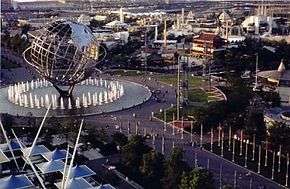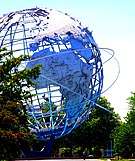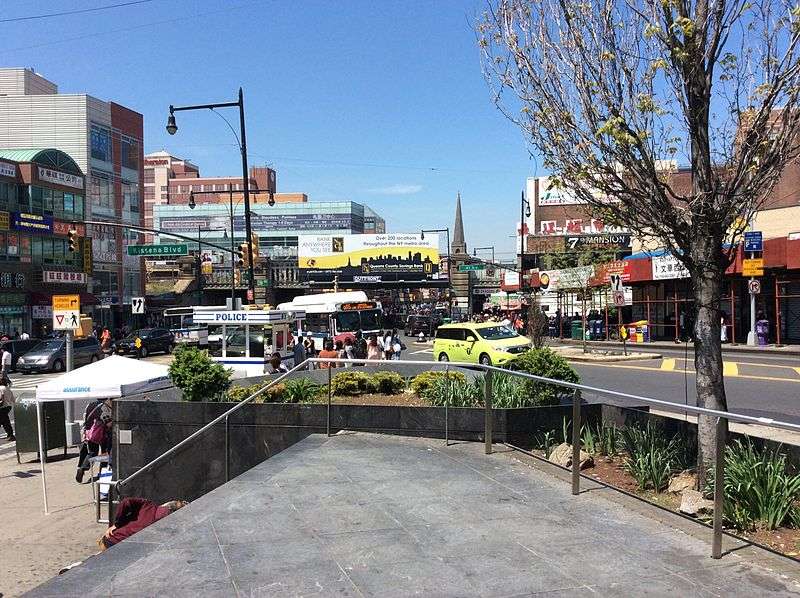Unisphere
The Unisphere is a spherical stainless steel representation of the Earth, located in Flushing Meadows–Corona Park in the borough of Queens, New York City. The sphere, which measures 140 feet (43 m) high and 120 feet (37 m) in diameter, was designed by Gilmore D. Clarke as part of his plan for the 1964 New York World's Fair.[1]
.jpg)
The Unisphere is located atop a 20-foot-tall (6.1 m) base with over 500 steel pieces representing the continents, as well as three steel rings representing the first artificial satellites orbiting Earth. Around the Unisphere is a reflecting pool measuring 310 feet (94 m) in diameter and surrounded by 48 pairs of fountain heads.
Commissioned to celebrate the beginning of the space age, the Unisphere was conceived and constructed as the theme symbol of the 1964–1965 New York World's Fair. The theme of the World's Fair was "Peace Through Understanding" and the Unisphere represented the theme of global interdependence, being dedicated to "Man's Achievements on a Shrinking Globe in an Expanding Universe". The Unisphere was restored after the conclusion of the World's Fair, but fell into disrepair in the 1970s, and was restored in the early 1990s. The Unisphere was made a New York City designated landmark in 1995.
History
Construction
| Attractions and Geographical Features of Flushing Meadows–Corona Park |
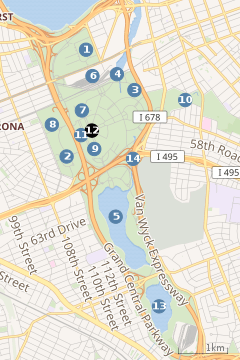 |
Attractions and geographical features of Flushing Meadows–Corona Park: 1 2 3 4 5 6 7 8 9 10 11 12 13 14 |
Flushing Meadows–Corona Park, a former ash dump in the borough of Queens, was used for the 1939/1940 New York World's Fair. At the conclusion of the fair, it was used as a park.[2][3] The Flushing Meadows site was selected in 1959 for the 1964 New York World's Fair.[4] Gilmore David Clarke and Michael Rapuano, designers of the original World's Fair layout, were retained to tailor the original 1939 park layout for the new fair.[5][6] New York City parks commissioner Robert Moses was president of the World's Fair Corporation, which leased the park from the city until 1967, after the fair's completion.[7]
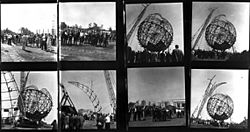

The Unisphere was announced by Moses in February 1961,[9] and a model of the proposed work was unveiled the following year.[10] The Unisphere was initially conceptually designed by Clarke in aluminum with metallic mesh continents.[6][11] It underwent a further refined industrial design in stainless steel by industrial designers at Peter Muller-Munk Associates.[12][13] The final design was similar to the original, except for the inclusion of fountains surrounding the Unisphere.[6]
The Unisphere was constructed by American Bridge Company, a division of US Steel.[6][11] The sphere was built within 110 days.[14] The last landmass was installed on August 13, 1963.[15]
World's Fair
During the 1964 fair, dramatic lighting at night gave the effect of sunrise moving over the surface of the globe. Additionally, the capitals of nations were marked by lights.[16] One of these lights is placed at the location of the Kahnawake Indian Reservation, which the Mohawk ironworkers requested to be placed there to honor their labor.[17]
In 1966, after the conclusion of the fair, US Steel donated $100,000 to make the Unisphere a permanent attraction at Flushing Meadows-Corona Park.[18] The park was reopened the next year following a major renovation, and the Unisphere was permanently retained as a park feature.[19] In subsequent years, the Unisphere fell into disrepair, being covered in grime by the 1970s, while the pools were shut off and tagged with graffiti.[16]
Rehabilitation
In 1989, the New York City Department of Parks and Recreation announced a multimillion-dollar rehabilitation of Flushing Meadows-Corona Park. Among the projects was a complete restoration of the Unisphere. The project, which began in 1993, included numerous structural repairs and removal of years' worth of grime accumulation on the steel. The fountains, shut off since the 1970s, were replaced, and new floodlighting installed.[20][21] Furthermore, two of the surrounding lawns were planted with rose gardens.[22] The restoration was completed in May 1994.[20] That year, the Annual Building Awards in Queens gave the Unisphere an award for best rehabilitation.[23] In May 1995, the New York City Landmarks Preservation Commission designated the Unisphere an official city landmark.[24][1]
The Unisphere's fountain reopened on August 12, 2010, after a $2 million restoration of its pumps, valves, and paintwork.[25][26] In addition, other sites say the globe and its surroundings, including its reflecting pool and fountains, were renovated at a cost of $3 million.[1] In the September 2010 Brooklyn/Queens tornadoes, the landmass representing Sri Lanka was blown off the Unisphere; the piece was reinstalled the following year.[27]
Design
Globe
.jpg)
The Unisphere is the world's largest globe. It measures 120 feet (37 m) in diameter, rises 140 feet (43 m), and weighs {{convert|700,000|lb|0},[16] Including its 100 short tons (91 t) inverted tripod base, which is made of a sturdy low-alloy steel, the Unisphere weighs 900,000 pounds (408,233 kg).[16][22] The sphere is constructed of Type 304L stainless steel. The continents on the sphere are fabricated with a special texture-pattern by Rigidized Metals Corporation.[28] The Unisphere is tilted at an angle of 23.5 degrees, which is the Earth's normal tilt.[16]
Three large orbit rings of stainless steel encircle the Unisphere at various angles. These orbit rings are believed to represent the tracks of Yuri Gagarin, the first man in space; John Glenn, the first American to orbit the Earth; and Telstar, the first active communications satellite.[16][29] The early design was to have a ring for each of a dozen satellites in place at the time of the Fair. This proved impractical, not only in the number of satellites, but also in the height of their orbits and the fact that geostationary satellites had no orbit path. As a result, a symbolic number of three was chosen for aesthetic reasons.[29] The three rings were connected with aircraft cable to the rest of the structure.[16]
The landmasses of the Unisphere are made of metal sheets that are laid in contours. The shapes had to be placed at regular intervals while also accurately representing the globe, and could not be cross-braced or overly thick; furthermore, wind was trapped by the shapes' concave inner surfaces. As such, a stress transfer pattern was developed, and the meridians and parallels were varied in dimension, thereby making the Unisphere structurally stable as well as accurate in design.[16]
Pool and fountains
The Unisphere is centered in a 310-foot-diameter (94 m) circular reflecting pool, with a floor of poured concrete surrounded by a bulkhead of granite and concrete. Forty-eight pairs of fountainheads, on the outer edge of the pool, are designed to obscure its tripod pedestal. The effect is meant to make the Unisphere appear as if it is floating in space. There are plaques facing the four major paths that extend north, northeast, southeast, and south from the Unishphere.[16] From the perimeter of the reflecting pool, the Unisphere is meant to depict the Earth as seen from 4,000 miles (6,400 km) away.[30]
Structural foundation
The Unisphere is built on a concrete foundation, which includes the piling ring that supported the Perisphere of the 1939 World's Fair.[16][11] The marshy soil of Flushing Meadows needed special consideration during the original 1937 Perisphere construction. The Perisphere, and subsequently the Unisphere, which used the same platform, employed a foundation of 528 pressure-creosoted Douglas fir piles of 95 to 100 feet (29 to 30 m) in length. Before construction of the Unisphere, three piles were tested for structural integrity and all were found to be sound throughout their entire length.[31]
Climbs on the Unisphere
The Unisphere was climbed in 1976 by George Willig (the so-called "Human Fly" who would later climb the World Trade Center), and Jerry Hewitt as part of a short film called The Third Stone Directed by Paul Hornstein. The Unisphere was not again scaled until September 6, 2019, when Glen Schleyer, a member of the climate activist group Extinction Rebellion, climbed the Unisphere to hang up a banner protesting the 2019 Amazon rainforest wildfires. He chose the Unisphere because it celebrates the World's Fair theme of "peace through understanding".[32]
References
Citations
- Jackson, Kenneth T., ed. (2010). The Encyclopedia of New York City (2nd ed.). New Haven: Yale University Press. ISBN 978-0-300-11465-2.
- "Ready to Turn Fair Into Park; Moses Tells Mayor His Plans Are Set" (PDF). The Sun (New York). Fultonhistory.com. August 15, 1940. p. 14. Retrieved March 27, 2017.
- "Flushing Meadow" (PDF). Long Island Star-Journal. Fultonhistory.com. July 13, 1949. p. 4. Retrieved March 27, 2017.
- La Guardia International Airport and John F. Kennedy International Airport, Port Authority of New York and New Jersey Airport Access Program, Automated Guideway Transit System (NY, NJ): Environmental Impact Statement. Port Authority of New York and New Jersey, United States Department of Transportation, Federal Aviation Administration, New York State Department of Transportation. June 1994. p. 1.11.
- "Flushing Meadows-Corona Park: Historic Preservation Studio". Columbia Graduate School of Architecture, Planning and Preservation. May 3, 2015. p. 16. Retrieved March 31, 2017.
- Landmarks Preservation Commission 1995, p. 3.
- Schumach, Murray (June 4, 1967). "MOSES GIVES CITY FAIR SITE AS PARK; Flushing Meadows in Queens Becomes the 2d Biggest Recreation Area Here". The New York Times. ISSN 0362-4331. Retrieved November 4, 2019.
- "Unisphere (under construction)". NYPL Digital Collections. Retrieved November 13, 2016.
- "A 120-Foot Steel 'Unisphere' Will Be Symbol of the '64 Fair". The New York Times. February 15, 1961. ISSN 0362-4331. Retrieved November 4, 2019.
- "Unisphere at 1964 World's Fair to Be 12 Stories High". The New York Times. April 24, 1962. ISSN 0362-4331. Retrieved November 4, 2019.
- Schmertz, Mildred F. (July 1964). "Architecture at the New York World's Fair" (PDF). Architectural Record. 136: 150.
- Kracklauer, Beth (November 19, 2015). "Mass-Market Masterpieces: The Designs of Peter Muller-Munk". Wall Street Journal. ISSN 0099-9660. Retrieved July 27, 2020.
- Gopnik, Blake (July 9, 2015). "Carnegie Museum to Open a Survey of the Designer Peter Muller-Munk". The New York Times. ISSN 0362-4331. Retrieved July 27, 2020.
- "Unisphere, 1960 - Photos - New York: The 1960s". New York Daily News. Retrieved November 13, 2016.
- "Section Added to Unisphere". The New York Times. August 13, 1963. ISSN 0362-4331. Retrieved November 4, 2019.
- Landmarks Preservation Commission 1995, p. 4.
- "Unisphere". Place Matters. September 24, 2015. Archived from the original on September 24, 2015. Retrieved July 27, 2020.
- "U.S. Steel Donates A Fund to Maintain Unisphere at Fair". The New York Times. March 21, 1966. ISSN 0362-4331. Retrieved November 4, 2019.
- Schumach, Murray (June 4, 1967). "Moses Gives City Fair Site as Park; Flushing Meadows in Queens Becomes the 2d Biggest Recreation Area Here". The New York Times. ISSN 0362-4331. Retrieved July 27, 2020.
- Huang, Vivian (June 1, 1994). "Let us spray for Unisphere". New York Daily News. p. 293. Retrieved November 4, 2019 – via newspapers.com

- Landmarks Preservation Commission 1995, p. 5.
- Muschamp, Herbert (September 2, 1994). "Summer's Last Hurrah: The Final Fling Before the Fall; Recircling the Globe". The New York Times. ISSN 0362-4331. Retrieved November 4, 2019.
- Belluck, Pam (October 11, 1995). "Queens Beauty Contest: Basic Brick Is Beautiful". The New York Times. ISSN 0362-4331. Retrieved November 4, 2019.
- Avashti, Surabhi (May 15, 1995). "Unisphere nears landmark status". New York Daily News. p. 292. Retrieved November 4, 2019 – via newspapers.com

- Hirshon, Nicholas (August 13, 2010). "Fountain's Return". New York Daily News. Retrieved September 3, 2010.
- Carlson, Jen (August 14, 2010). "Finally: Unisphere Fountain Restored!". Gothamist. Retrieved July 27, 2020.
- Kilgannon, Corey (August 21, 2011). "When a Tornado in Queens Becomes an International Incident". City Room. Retrieved November 4, 2019.
- Brake, Alan G. (February 26, 2014). "Focus on Fabrication> Rigidized Metals". The Architect's Newspaper. Archived from the original on February 26, 2014. Retrieved July 27, 2020.
- Short, Daniel (2016). Unisphere: Symbol of the 1964-1965 New York World's Fair (1st ed.). Arethusa Press. ISBN 978-0-692-50867-1.
- Landmarks Preservation Commission 1995, p. 6.
- American Wood Preservers Institute; American Wood-Preservers' Association (1965). Wood Preserving News. American Wood Preservers Institute. p. 16. Retrieved July 27, 2020.
- Kim, Elizabeth (September 9, 2019). "Man Climbs World's Fair Unisphere To Draw Attention To Climate Change". Gothamist. Archived from the original on September 10, 2019. Retrieved September 14, 2019.
Sources
- "The Unisphere" (PDF). New York City Landmarks Preservation Commission. May 16, 1995.
External links
| Wikimedia Commons has media related to Unisphere. |
- Internet Archive: The Unisphere: Biggest World on Earth (1964), film about the creation of the Unisphere
